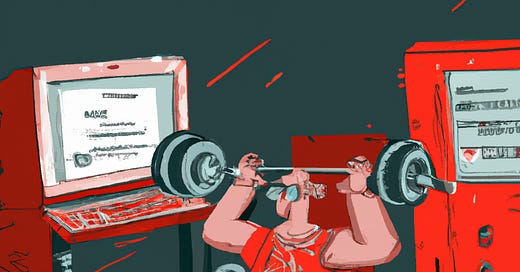Strength training principles for software engineers
As I wrote about in Optimising your life, it’s very easy for technologists and builders like myself to focus their energies on perfecting something they know and understand, rather than exploring things they do not.
Whilst my point in that article was that we should look to explore more than we look to perfect, exercise is a good counter-example.
When exercising, focus, discipline and practice should be our aim.
So, after hundreds of hours in the gym over the last few years, I decided to compile a list of rules and prompts that have guided me whilst strength-training.
Whilst this list won’t help you in selecting exercises or design a strength-training program, It will act as a guide on how to perform exercises within a workout — so that you can become your strongest, healthiest, and most-jacked self1.
Let’s begin!

Use a full range of motion ⚖️
Always perform an exercise with the full range of motion, focusing on achieving a full stretch at the end-range of motion. If mobility permits, squat till your bum touches your ankles, dumbbell curl until your elbows are fully extended and so on, so that it feels like the fibres in your muscle are physically being torn apart.
Not only is there unequivocal evidence that a deep stretch causes greatest potential for muscle growth2, a full range of motion makes an exercise much harder — allowing you to use less weight for the same growth stimulus, thereby reducing the chance of injury.
And finally, a standardised range of motion (when your first and last reps of a set look identical) helps you track your reps much more accurately.
Explosive concentric, controlled eccentric 🚀
The concentric part of an exercise — when the target muscle contracts (ie when you drive up from the bottom of a squat, or stand up from the bottom of the deadlift) — should be explosive 💥
This leads to greatest recruitment of type II muscle fibers, which have the greatest ablility to for muscle growth and force production.
The eccentric part of an exercise — when the target muscle lengthens — should be slow and controlled, at least 1-2 seconds. Do not simply ‘drop’ the weight — this removes any chance of muscle growth whilst greatly increasing your risk of injury.
Find a technique that leads to least fatigue for the stimulus 🤓
Put simply, you should ensure that the target muscle is the limiting factor in your exercise. Fatigue in that muscle should be the only reason you stop — not fatigue in any other muscle or general systemic fatigue in your body.
For example, if you aim to target your back when doing pull-ups and you find your grip giving out half-way though a set, use wrist straps! This ensures that instead of training your grip, you’re training your back, so that you can achieve the size and strength that you desire.
Each set should be close to failure 🥵
You should work hard in each and every set — within 1-2 reps of failure. This is regardless if you’re aiming for 5-30 reps for developing size or 1-5 reps for developing strength.
This is the best trade-off between providing a strong stimulus for growth and not creating too much fatigue that would take too long to recover from.
So, how do you estimate how many reps you’re holding in the tank? For that, I refer you to the excellent RP YouTube channel, which has great videos on all things strength training:
No cheating! ❌
I don’t need to explain this — you know what cheating is! And just as with many other things in life, I too will know it when I see it.
Technically speaking, cheating in an exercise is using any muscles other than the target muscles in an exercise. If you do use the non-target muscles, then the exercise is no longer useful — it doesn’t support your strength or size goals, and causes unnecessary risk of injury. There’s simply no point in you continuing.
If you fail on any of these, then you’ve achieved technical failure — congrats! It’s time for you to complete the set, take a break, attempt another set, move onto another exercise or go home!
I’d love to hear your thoughts on how to get the most of your workouts, too — please do share!
Till next week,
Light weight baby 💪3
Most of this advice is relevant to beginner and intermediate trainees. if you’re an absolute beginner, I suggest you start elsewhere!



